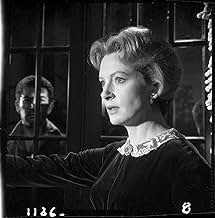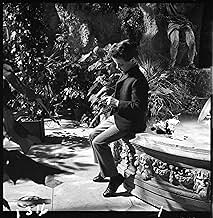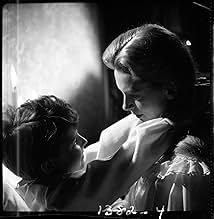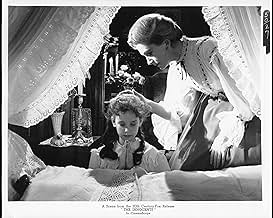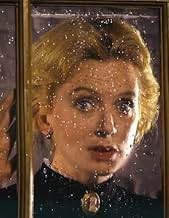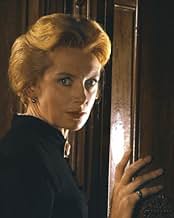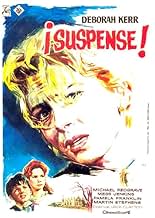Una giovane governante si convince che la casa è posseduta.Una giovane governante si convince che la casa è posseduta.Una giovane governante si convince che la casa è posseduta.
- Regia
- Sceneggiatura
- Star
- Nominato ai 2 BAFTA Award
- 4 vittorie e 5 candidature totali
Recensioni in evidenza
They sure don't make movies like this one anymore. This is one of the few horror movies that does not have gory or graphic images in it. Instead, the spooks in this movie are presented in a subtle way....yet, the movie is quite scary. This is the type of horror movie that I like, one in which every now and then you see a frightening image or a startling scene, and that image or scene lingers in your mind.
Everything about this movie is haunting. First, there's the song at the beginning: you hear a young girl's voice singing a beautiful yet somber song. Later you hear that song in several scenes in the movie.
Second, there's the setting: this movie takes place in a large Victorian mansion with many rooms and passages, while only about eight people live in it....what could be more eerie than that?
Then there's the exceptional cinematography. The black-and-white photography is perfect for this movie. This movie would not have been too creepy if it had been done in color. Further, many of the shots were innovative and the lighting was used ingeniously in some of the scenes.
Additionally, I liked the way that the director chose to play around with the sound, which brought more of an element of mystery to the movie. In one particular scene, there was a lot of noise initially....and in a split second there was dead silence....then several seconds later, it was noisy all over again (all in the same scene).
But what I think is the most interesting thing about this movie is the fantastic performance by Deborah Kerr. It's fascinating to watch her facial expressions in this movie. She demonstrates her character's fear quite well.
I also think that the actor who plays Quint is very scary-looking! He has a very sinister look, and it adds to the spookiness of this movie. If you really want to be spooked by this movie, watch it late at night with all of the lights off....dare to watch it by yourself.
Everything about this movie is haunting. First, there's the song at the beginning: you hear a young girl's voice singing a beautiful yet somber song. Later you hear that song in several scenes in the movie.
Second, there's the setting: this movie takes place in a large Victorian mansion with many rooms and passages, while only about eight people live in it....what could be more eerie than that?
Then there's the exceptional cinematography. The black-and-white photography is perfect for this movie. This movie would not have been too creepy if it had been done in color. Further, many of the shots were innovative and the lighting was used ingeniously in some of the scenes.
Additionally, I liked the way that the director chose to play around with the sound, which brought more of an element of mystery to the movie. In one particular scene, there was a lot of noise initially....and in a split second there was dead silence....then several seconds later, it was noisy all over again (all in the same scene).
But what I think is the most interesting thing about this movie is the fantastic performance by Deborah Kerr. It's fascinating to watch her facial expressions in this movie. She demonstrates her character's fear quite well.
I also think that the actor who plays Quint is very scary-looking! He has a very sinister look, and it adds to the spookiness of this movie. If you really want to be spooked by this movie, watch it late at night with all of the lights off....dare to watch it by yourself.
Miss Giddens (Deborah Kerr) is hired to be the governess to two children on a country estate. She comes to believe the place and the children are haunted by the spirits of their previous governess and her brutish lover. No one else believes her so she tries to get rid of the ghosts herself.
The first screen adaptation of Henry James's "The Turn of the Screw, " a psychological ghost story that leaves unanswered the question of whether the ghosts are real or imagined. This sort of story is pretty common in movies of the last 20 years but was much less so in 1898 or even 1961. Don't let the ambiguity put you off that there are no scares here. This is a movie full of spooky moments, shadowy figures, startling reflections, eerie voices. It's beautifully photographed by Freddie Francis. The music and sound effects add to the feeling of unease. Deborah Kerr gives a nail-biting performance as the neurotic, repressed Miss Giddens. The child actors, Pamela Franklin and Martin Stephens, are sufficiently precocious and weird to keep you off balance as to the truth behind their possession. Stephens was the leader of the kids in Village of the Damned. Franklin would go on to appear in such '70s greats as And Soon the Darkness and The Legend of Hell House. Megs Jenkins is good as the kindly housekeeper. Peter Wyngarde is creepy as the menacing Quint.
The pace is slow, which will turn off impatient viewers, and the scares are subtle and not as visceral as most modern horror fans seem to enjoy. But if you like thoughtful horror films then this is one you'll want to see. Fans of the suggestive classics Val Lewton produced in the '40s should also check this out.
The first screen adaptation of Henry James's "The Turn of the Screw, " a psychological ghost story that leaves unanswered the question of whether the ghosts are real or imagined. This sort of story is pretty common in movies of the last 20 years but was much less so in 1898 or even 1961. Don't let the ambiguity put you off that there are no scares here. This is a movie full of spooky moments, shadowy figures, startling reflections, eerie voices. It's beautifully photographed by Freddie Francis. The music and sound effects add to the feeling of unease. Deborah Kerr gives a nail-biting performance as the neurotic, repressed Miss Giddens. The child actors, Pamela Franklin and Martin Stephens, are sufficiently precocious and weird to keep you off balance as to the truth behind their possession. Stephens was the leader of the kids in Village of the Damned. Franklin would go on to appear in such '70s greats as And Soon the Darkness and The Legend of Hell House. Megs Jenkins is good as the kindly housekeeper. Peter Wyngarde is creepy as the menacing Quint.
The pace is slow, which will turn off impatient viewers, and the scares are subtle and not as visceral as most modern horror fans seem to enjoy. But if you like thoughtful horror films then this is one you'll want to see. Fans of the suggestive classics Val Lewton produced in the '40s should also check this out.
"The Innocents" is one of those films that prove subtlety and imagination can be ten times more terrifying than loud noises or things that go bump in the night. There are no raging spirits or escaped madmen here. Nor will you find that stock of today's second rate horror films -- the creature that embodies evil and finds amazingly obscure ways in which to slaughter naughty teenagers. No, this movie scars one's psyche with darkness and silence and possibility, all mingled with its refusal to give the audience an easy answer at the end.
Based on Henry James' novella, "The Turn Of The Screw," the story is deceptively simple. An inexperienced governess is hired to care for two orphaned children in an isolated British manor and slowly comes to believe the ghosts of the previous governess and her brutish lover are trying to possess the children's souls. Being a decent woman "who loves children," she fights back the only way she can -- by confronting the evil head on. But the question is, does the evil truly exist...or is it all in her own mind?
As told by James, the novella is a startling ghost story, without question. He adds his usual psychological insights to the characters, but never do you doubt the ghosts exist. The defining moment comes when Miss Giddens sees Quint's face in a dark window then later finds a locket bearing his portrait and comes to her realization, "Oh, he's a ghost!" But in the movie, Truman Capote and William Archibald reverse this sequence -- she finds the locket first and THEN sees the man's face in the window -- and all simple explanations go out the door.
Is Miss Giddens imagining things? Has she become overwhelmed by the responsibility of raising two precocious children without any sort of support from their selfish uncle? Is she merely sexually repressed and immature enough to transfer her crush on the uncle to a boy not even into puberty yet? And what of Flora, Miles' sister? If this is merely sexual repression on Miss Giddens' part, then why does she drag a little girl into the morass? Throughout the film, Miss Giddens offers evidence of her concerns -- a letter received from Miles' schoolmaster that she cannot fully share with Mrs. Grose because the woman cannot read; her awareness that the two innocents in her charge have a far more advanced knowledge of life than children that age normally would; stories told by Mrs. Grose about Miss Jessel and Quint and how they treated the children. So could it be the spirits of two miserable adults have come back to reclaim life in the persons of Miles and Flora? It could go either way.
There is not one wrong moment in this movie. Not one. The first time I saw it was in New York City on a double bill with "The Haunting" (1963), a "things that go bump in the night" kind of movie. The audience and I howled through that one, it was so much silly fun. And we chuckled through the first ten minutes of "The Innocents" (especially when Mrs. Grose tells Miss Giddens, "I'm SO glad you're here," with a little quiver in her voice), but by the end of that film (and I use the word "film" deliberately), the entire theater was dead silent. Any film that can shut up a room full of rowdy New Yorkers has got to be damned good.
So...is "The Innocents" a ghost story or psychological study? Who can say? And to be honest, who cares? It is, at the very least, a damned good movie...and at the very best, a horror story that makes "The Shining," "Rosemary's Baby," "The Others" and even "Psycho" (a movie I love) look like the works of children. That this film is not available on DVD is a travesty.
Based on Henry James' novella, "The Turn Of The Screw," the story is deceptively simple. An inexperienced governess is hired to care for two orphaned children in an isolated British manor and slowly comes to believe the ghosts of the previous governess and her brutish lover are trying to possess the children's souls. Being a decent woman "who loves children," she fights back the only way she can -- by confronting the evil head on. But the question is, does the evil truly exist...or is it all in her own mind?
As told by James, the novella is a startling ghost story, without question. He adds his usual psychological insights to the characters, but never do you doubt the ghosts exist. The defining moment comes when Miss Giddens sees Quint's face in a dark window then later finds a locket bearing his portrait and comes to her realization, "Oh, he's a ghost!" But in the movie, Truman Capote and William Archibald reverse this sequence -- she finds the locket first and THEN sees the man's face in the window -- and all simple explanations go out the door.
Is Miss Giddens imagining things? Has she become overwhelmed by the responsibility of raising two precocious children without any sort of support from their selfish uncle? Is she merely sexually repressed and immature enough to transfer her crush on the uncle to a boy not even into puberty yet? And what of Flora, Miles' sister? If this is merely sexual repression on Miss Giddens' part, then why does she drag a little girl into the morass? Throughout the film, Miss Giddens offers evidence of her concerns -- a letter received from Miles' schoolmaster that she cannot fully share with Mrs. Grose because the woman cannot read; her awareness that the two innocents in her charge have a far more advanced knowledge of life than children that age normally would; stories told by Mrs. Grose about Miss Jessel and Quint and how they treated the children. So could it be the spirits of two miserable adults have come back to reclaim life in the persons of Miles and Flora? It could go either way.
There is not one wrong moment in this movie. Not one. The first time I saw it was in New York City on a double bill with "The Haunting" (1963), a "things that go bump in the night" kind of movie. The audience and I howled through that one, it was so much silly fun. And we chuckled through the first ten minutes of "The Innocents" (especially when Mrs. Grose tells Miss Giddens, "I'm SO glad you're here," with a little quiver in her voice), but by the end of that film (and I use the word "film" deliberately), the entire theater was dead silent. Any film that can shut up a room full of rowdy New Yorkers has got to be damned good.
So...is "The Innocents" a ghost story or psychological study? Who can say? And to be honest, who cares? It is, at the very least, a damned good movie...and at the very best, a horror story that makes "The Shining," "Rosemary's Baby," "The Others" and even "Psycho" (a movie I love) look like the works of children. That this film is not available on DVD is a travesty.
The Innocents is a masterpiece of atmospheric horror cinema. The obvious influence for 2001's 'The Others', The Innocents portrays themes of paranoia, death and madness; superbly wrapped around a plethora of great performances from the four main leads.
The story revolves around an uncle who doesn't have time for the children he has inherited, and therefore hires Miss Giddens (Deborah Kerr) to look after them. When Miss Giddens arrives at the mansion, she first meets Flora, the young girl and is 'enchanted' by the child. A few days later the boy, Miles, arrives at the house after being expelled from school. The fourth lead is made up by the housekeeper, Mrs Grose; played by Meg Jenkins. From the housekeeper, Miss Giddens eventually learns of what happened to the previous occupants of the house, and that's where the fun starts...
Martin Stephens (Miles) and Pamela Franklin (Flora) do surprisingly good jobs as the two adorable young children that are the centre of the story. Their characters are portrayed as nice young children, but at the same time there is something sinister about them, and that is where the tale draws a lot of it's suspense and mystery from. Deborah Kerr also shines as the watcher of the children. We know from the outset that her character loves children, which makes her plight believable to the audience when she does all she can to save the children from the evil she believes is haunting them. We never really know what is happening in the movie; the children's viewpoints contradict that of Miss Giddens, and as there is evidence to support what both sides say, along with evidence to support that of the contrary, the mystery is able to build itself through this and that, therefore, along with the empathy we are able to feel for Mrs Giddens due to the nature of her character; the film is able to remain interesting and suspenseful for it's running time.
The thing that this film does best is in capturing a dark and foreboding atmosphere. Through the way the story is portrayed and the beautiful cinematography, Jack Clayton is able to create scenes and sequences that are genuinely frightening and suspenseful; less is more rarely works to a great effect, but here it does. The 'ghosts' have very little screen time, but the time they do have is powerful and memorable enough to make it seem like much more. The film's creepy and menacing atmosphere never delves into violence or gore and relies solely on the story itself and the Gothic, atmospheric setting; and that is much to the film's credit.
If you liked the slightly later 60's paranoid horror films, such as Carnival of Souls or The Haunting, then this film is definitely one to check out.
The story revolves around an uncle who doesn't have time for the children he has inherited, and therefore hires Miss Giddens (Deborah Kerr) to look after them. When Miss Giddens arrives at the mansion, she first meets Flora, the young girl and is 'enchanted' by the child. A few days later the boy, Miles, arrives at the house after being expelled from school. The fourth lead is made up by the housekeeper, Mrs Grose; played by Meg Jenkins. From the housekeeper, Miss Giddens eventually learns of what happened to the previous occupants of the house, and that's where the fun starts...
Martin Stephens (Miles) and Pamela Franklin (Flora) do surprisingly good jobs as the two adorable young children that are the centre of the story. Their characters are portrayed as nice young children, but at the same time there is something sinister about them, and that is where the tale draws a lot of it's suspense and mystery from. Deborah Kerr also shines as the watcher of the children. We know from the outset that her character loves children, which makes her plight believable to the audience when she does all she can to save the children from the evil she believes is haunting them. We never really know what is happening in the movie; the children's viewpoints contradict that of Miss Giddens, and as there is evidence to support what both sides say, along with evidence to support that of the contrary, the mystery is able to build itself through this and that, therefore, along with the empathy we are able to feel for Mrs Giddens due to the nature of her character; the film is able to remain interesting and suspenseful for it's running time.
The thing that this film does best is in capturing a dark and foreboding atmosphere. Through the way the story is portrayed and the beautiful cinematography, Jack Clayton is able to create scenes and sequences that are genuinely frightening and suspenseful; less is more rarely works to a great effect, but here it does. The 'ghosts' have very little screen time, but the time they do have is powerful and memorable enough to make it seem like much more. The film's creepy and menacing atmosphere never delves into violence or gore and relies solely on the story itself and the Gothic, atmospheric setting; and that is much to the film's credit.
If you liked the slightly later 60's paranoid horror films, such as Carnival of Souls or The Haunting, then this film is definitely one to check out.
8cuz
What makes a good chiller? Gore, special effects? No, as director Jack Clayton proves here, it's atmosphere, combined with the sounds of horror, that makes the difference. Granted, I've seen just about every Elm Street and Friday the 13th instalment, but "The Innocents" proves that what you don't see can scare you the most. Deborah Kerr is in fine form as an English governess who is sent to a remote mansion in the country to look after two young orphans. Their "uncle" in London doesn't have time for them. Kerr slowly begins to realize there's something not quite right with the young boy and girl. Their thoughts and actions are not consistent with the behavior of pre-teens. There's a dark secret, and Kerr sets out to discover it. We do see the ghosts, but it's when Kerr searches the house for the sources of strange noises and voices that we really feel a chill. "The Innocents" also makes great use of its black and white photography. I can't imagine it working as well in color (are you listening, Gus Van Sant?). Shadows just seem creepier in black and white. The children are well played by Martin Stephens and Pamela Franklin. Franklin was 11 when she made this film, and as an adult she would go on to star in another excellent haunted house movie, "The Legend of Hell House." It's a shame that Hollywood has stopped making movies like "The Innocents." Perhaps audiences used to Halloween-style slashers, "Scream" and "I Know What You Did Last Summer" would be demanding blood and guts. Yes, "Scream" was, pardon the pun, a cut above. It raised the slumping horror bar to new heights, and then "I Know..." ran under that bar, but that's another story. If you want genuine chills rather than cheap thrills, you can't do much better than "The Innocents."
Lo sapevi?
- QuizTo create such sharp visuals, director of photography Freddie Francis used lots of huge bright lamps. Deborah Kerr sometimes had to resort to wearing sunglasses between takes. He also had candles custom made with four or five wicks entwined to produce more light.
- BlooperAn obvious center back zipper in several of Miss Kerr's costumes, as well as in Mrs. Gross & Flora's costumes. The Innocents is set during the Victorian period, 1837-1901. Commercial zippers were not used in clothing until 1925.
- Citazioni
Miles: What shall I sing to my lord from my window? What shall I sing for my lord will not stay? What shall I sing for my lord will not listen? Where shall I go when my lord is away? Whom shall I love when the moon is arisen? Gone is my lord and the grave is his prison. What shall I say when my lord comes a calling? What shall I say when he knocks on my door? What shall I say when his feet enter softly? Leaving the marks of his grave on my floor. Enter my lord. Come from your prison. Come from your grave, for the moon is a risen. Welcome, my lord.
- Curiosità sui creditiThe film begins with a totally black screen and the sound of Flora singing for several seconds; then the 20th Century Fox logo fades in and out. The singing continues for a few seconds before the opening credits begin. As the credits display, we see an anguished Miss Giddens praying on the left side of the screen. Her actions are not explained until the film's climax.
- ConnessioniFeatured in Aweful Movies with Deadly Earnest: The Innocents (1974)
I più visti
Accedi per valutare e creare un elenco di titoli salvati per ottenere consigli personalizzati
- How long is The Innocents?Powered by Alexa
- What is "The Innocents" about?
- Is "The Innocents" based on a book?
- What does "the turn of the screw" mean?
Dettagli
- Data di uscita
- Paesi di origine
- Lingua
- Celebre anche come
- Posesión satánica
- Luoghi delle riprese
- Azienda produttrice
- Vedi altri crediti dell’azienda su IMDbPro
Botteghino
- Budget
- 430.000 £ (previsto)
- Lordo in tutto il mondo
- 30.221 USD
- Tempo di esecuzione1 ora 40 minuti
- Colore
- Proporzioni
- 2.35 : 1
Contribuisci a questa pagina
Suggerisci una modifica o aggiungi i contenuti mancanti




